Mar 08 2009
Rory Gallagher Live at the Glasgow Apollo — 1982

Glasgow: Second City of the Empire

Located on the banks of the River Clyde, in West Central Scotland, the City of Glasgow is Scotland’s largest city and the third largest city in the United Kingdom. With a history dating back over 2 thousand years, Glasgow was one of the premier cities of Europe and came to be known as the ‘Second City of the Empire’. Glasgow’s position on the River Clyde, where Trade Winds first hit Europe, gave its merchants a two to three week advantage over other ports in Britain and Europe. The port city thrived on the West Indian and American trade agreements and become one of the richest cities in 18th century Europe. Glasgow merchants, such as John Glassford and James Dunlop made obscene amounts of money off the tobacco trade and built huge mansions laid out on streets named after themselves on the western edge of the city. These merchants would come to be known as the “Tobacco Lords”.
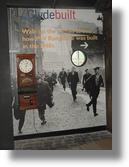 The close proximity of the largest coal fields and the richest iron-ore mines in all the British Isles kept the city of Glasgow in good stead for the ensuing Industrial Revolution, and Glasgow turned their new found industrial might to the building of ships and steam locomotives. “More ships were built on the banks of the Clyde before the war than in England, Germany and America put together.” These were exported throughout the world, and the term “Clyde-Built” became synonymous with solidity and reliability. In the 20th century however, Glasgow experienced a severe economic downturn as demands for ships and locomotives dwindled due to increase competition overseas. Today most of the shipyards on the River Clyde have disappeared; houses now stand where once the great oceanliners such as the Queen Mary and Queen Elizabeth were built.
The close proximity of the largest coal fields and the richest iron-ore mines in all the British Isles kept the city of Glasgow in good stead for the ensuing Industrial Revolution, and Glasgow turned their new found industrial might to the building of ships and steam locomotives. “More ships were built on the banks of the Clyde before the war than in England, Germany and America put together.” These were exported throughout the world, and the term “Clyde-Built” became synonymous with solidity and reliability. In the 20th century however, Glasgow experienced a severe economic downturn as demands for ships and locomotives dwindled due to increase competition overseas. Today most of the shipyards on the River Clyde have disappeared; houses now stand where once the great oceanliners such as the Queen Mary and Queen Elizabeth were built.
Apollo Theatre — Glasgow, Scotland

Perched at the top of Glasgow’s Renfield Street was the Apollo Theatre. Originally known as Green’s Playhouse, the theatre was a vast 3-story structure that at one time housed a cinema, a ballroom, 3 cafes and assorted lobbies and waiting rooms. Built in 1927 for Bert and Fred Green, the most successful cinema proprietors and film renters in Scotland, Green’s Playhouse was the largest cinema in all of Europe, with a seating capacity of 4,200. By the mid-sixties however, the cinema was having trouble filling the auditorium and began using the venue more and more for rock concerts. The measure proved only a temporary remedy and Green’s Playhouse closed it’s doors on June 30, 1973.
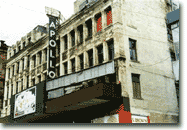 The venerable theatre would not stayed closed for long however, and 3 short months later it reopened its doors under new management, Unicorn Leisure, and with a fresh coat of paint and new name: the Apollo Theatre. Under the experienced hand of Unicorn Leisure’s management, it became the leading concert house in all of Scotland. The sheer size of the venue and it’s elevated stage could be daunting, but the winning over of the typical Glaswegian crowd was the true test of a band’s mettle. A Glasgow audience was said to be one of the most demanding in the world. “Such was its reputation that one relieved act is reputed to have printed T-shirts saying: I Played the Apollo … and Survived.” — www.inthewilderness.com/apollo
The venerable theatre would not stayed closed for long however, and 3 short months later it reopened its doors under new management, Unicorn Leisure, and with a fresh coat of paint and new name: the Apollo Theatre. Under the experienced hand of Unicorn Leisure’s management, it became the leading concert house in all of Scotland. The sheer size of the venue and it’s elevated stage could be daunting, but the winning over of the typical Glaswegian crowd was the true test of a band’s mettle. A Glasgow audience was said to be one of the most demanding in the world. “Such was its reputation that one relieved act is reputed to have printed T-shirts saying: I Played the Apollo … and Survived.” — www.inthewilderness.com/apollo
…we were all really, really nervous….Glaswegians were said to be the most difficult of any audience in Britain, especially on a Friday night…when they got paid and got pissed.
— excerpt from Sharon Osbourne’s autobiography, ‘Extremes’
I remember at the time thinking this is rock’n’roll, just standing on that stage at the Apollo in front of so many people, and having to get roadies to wring out the sweat from our T-shirts because we were so hot…the Apollo was a terrifying venue because the stage was so high. You felt very, very exposed up there and, added to that, you had a hard, industrial audience. I think if you got off on the wrong foot it would be a disaster…–Rick Parfitt, Status Quo
The old Glasgow Apollo was wild; the balcony used to visibly bounce up and down. I was there with Lynyrd Skynyrd in ’75 when a midget fell from the first circle into the stalls. It was one hell of a shock, but I can laugh about it now. If I’m being honest, I could laugh about it then as well. I’m not proud of that.– Steve Coogan
Back to My Old Stompin’ Ground
 Rory Gallagher played the Apollo on 10 separate occasions and at least one time when it was still Green’s Playhouse. If Belfast was regarded as Rory’s “second home” then Glasgow was surely a close third, and when visiting Scotland’s ‘Second City’, the Apollo Theatre would have been his preferred “Stompin’ Ground”. Reviews of several of his performances there can be found in John Ganjamie’s excellant repository of articles at roryon.com: article 1, article 2, and article 3. But in a nutshell, Rory Gallagher’s shows at the Apollo were simply incredible.
Rory Gallagher played the Apollo on 10 separate occasions and at least one time when it was still Green’s Playhouse. If Belfast was regarded as Rory’s “second home” then Glasgow was surely a close third, and when visiting Scotland’s ‘Second City’, the Apollo Theatre would have been his preferred “Stompin’ Ground”. Reviews of several of his performances there can be found in John Ganjamie’s excellant repository of articles at roryon.com: article 1, article 2, and article 3. But in a nutshell, Rory Gallagher’s shows at the Apollo were simply incredible.
[I] remember seeing the Amazing Mr.Gallagher on 2 march 1973 [at Green’s Playhouse] support was Greenslade (they didnt have a guitarist). A banner above the stage saying “its good its guiness”with guiness scored out and GALLAGHER put in instead.Classic set included tracks from the Blueprint album too! High point of the night was when Gerry McAvoy told us it was Rory’s birthday and, already on our feet, we sang happy bithday to him! That Famous Choir never sounded better and the measure of the man is how humble he was, genuinely touched by our affection for him! 1 of the few real gentlemen in the business he is so sadly missed.–www.inthewilderness.com/apollo
A battered strat; a tartan shirt; hair clinging to his face with sweat; total dedication to his music – and his fans. This quiet-spoken gentle man was once the darling of Glasgow’s Apollo Theatre and I saw him there.
He had injured his hand, and while many others would cancel a gig (or a tour) we knew Rory would come. For an hour and a half or so, the Glasgow crowd kept up a seemingly constant chant of “Rory! Rory! Rory!”.The houselights went up but no-one moved – there may have been an announcement but no-one would have heard. The balcony was bouncing to the stamp of the audience’s feet. Then,quite slowly and without introduction he walked onto the stage – the place exploded. The energy and anticipation the crowd gave off can’t be described. They made it a great gig – and Rory didn’t let them down. — rockmine.com
So have a listen to Rory Gallagher at the Apollo Theatre on May 28, 1982, his electrifying guitar work hitting you between the eyes like a Glasgow Kiss.*
- Download an mp3 of Rory’s show at the Apollo,
HERE. - Receive notification when a new bootleg is uploaded, HERE.
- Listen to the concert on your computer right now, HERE
(You must have Adobe Flash Player 9 installed)
- *A Glasgow Kiss
- A Headbutt to the lumpy bit on the nose. The headbutt is much used as a method of attack in Glasgow pubs on a friday night- hence the name The Glasgow Kiss.
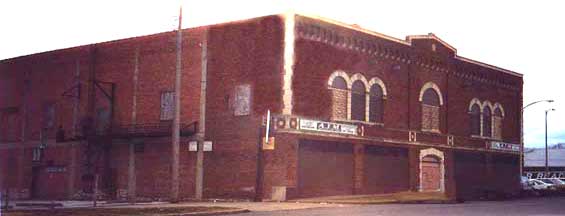
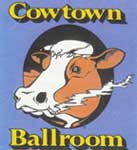 The place has undergone several revisions since it’s grand opening. In 1936 the El Torreon became the Avalon Supper Club and then in the early sixties, the El Torreon Roller Rink. By 1971 the building had returned to it’s musical roots and become the popular rock and roll venue, the Cowtown Ballroom. With the mirrored ball still suspended from its historic ceiling (*editor’s note: the mirrored ball was later donated to the Kansas City Museum in 1978), the open floored, and generally seat-less ballroom lent itself to a near festival like atmosphere, with concert goers pulling up a blanket or quilt and staking out their bit of floor space to watch the show.
The place has undergone several revisions since it’s grand opening. In 1936 the El Torreon became the Avalon Supper Club and then in the early sixties, the El Torreon Roller Rink. By 1971 the building had returned to it’s musical roots and become the popular rock and roll venue, the Cowtown Ballroom. With the mirrored ball still suspended from its historic ceiling (*editor’s note: the mirrored ball was later donated to the Kansas City Museum in 1978), the open floored, and generally seat-less ballroom lent itself to a near festival like atmosphere, with concert goers pulling up a blanket or quilt and staking out their bit of floor space to watch the show.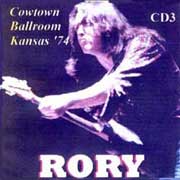 The first show was on July 16, 1971, a concert by the Flying Burrito Brothers, and the Ballroom would host a wide variety of Rock ‘n Roll acts before it would close down for good on September 16, 1974. Rory Gallagher, Nitty Gritty Dirt Band, Frank Zappa and the Mothers of Invention, Grateful Dead, and King Crimson were just a few of the name bands that performed there. The building still stands today. Until recently the downstairs was being used for Nite Club acts, small concerts, and practice space for musicians with the famous upstairs ballroom being used as a storage facility for the most recent owners of the building. Unfortunately, at this writing, the El Torreon Ballroom has shut its doors, and it is unknown whether the famous ballroom will ever return to its former glory. The Cowtown Ballroom refuses to be forgotten however, and there is a documentary film being made about the legendary venue titled,
The first show was on July 16, 1971, a concert by the Flying Burrito Brothers, and the Ballroom would host a wide variety of Rock ‘n Roll acts before it would close down for good on September 16, 1974. Rory Gallagher, Nitty Gritty Dirt Band, Frank Zappa and the Mothers of Invention, Grateful Dead, and King Crimson were just a few of the name bands that performed there. The building still stands today. Until recently the downstairs was being used for Nite Club acts, small concerts, and practice space for musicians with the famous upstairs ballroom being used as a storage facility for the most recent owners of the building. Unfortunately, at this writing, the El Torreon Ballroom has shut its doors, and it is unknown whether the famous ballroom will ever return to its former glory. The Cowtown Ballroom refuses to be forgotten however, and there is a documentary film being made about the legendary venue titled, 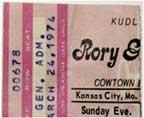 Although it’s listed on the bootleg jacket that Rory performed at the Cowtown Ballroom in August of 1974, probably the concert was given several months earlier. An image of the concert ticket stub found on a Kansas City memorabilia web site gives the concert date as Sunday evening, March 24, 1974. Special thanks go to Brenda O’Brien for finding this ticket stub. The opening act for the show that night was a regional favorite called, “Tide”, originally fronted by guitar slinger Jim Stringer. The band played the Cowtown Ballroom often, and has since been inducted into the Kansas City Music Hall of Fame. They were no match for Rory however:
Although it’s listed on the bootleg jacket that Rory performed at the Cowtown Ballroom in August of 1974, probably the concert was given several months earlier. An image of the concert ticket stub found on a Kansas City memorabilia web site gives the concert date as Sunday evening, March 24, 1974. Special thanks go to Brenda O’Brien for finding this ticket stub. The opening act for the show that night was a regional favorite called, “Tide”, originally fronted by guitar slinger Jim Stringer. The band played the Cowtown Ballroom often, and has since been inducted into the Kansas City Music Hall of Fame. They were no match for Rory however: